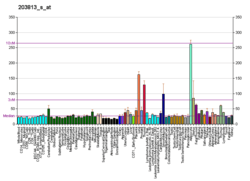SLIT3
Slit homolog 3 protein is a protein that in humans is encoded by the SLIT3 gene.[5][6][7]
References
- GRCh38: Ensembl release 89: ENSG00000184347 - Ensembl, May 2017
- GRCm38: Ensembl release 89: ENSMUSG00000056427 - Ensembl, May 2017
- "Human PubMed Reference:". National Center for Biotechnology Information, U.S. National Library of Medicine.
- "Mouse PubMed Reference:". National Center for Biotechnology Information, U.S. National Library of Medicine.
- Nakayama M, Nakajima D, Nagase T, Nomura N, Seki N, Ohara O (July 1998). "Identification of high-molecular-weight proteins with multiple EGF-like motifs by motif-trap screening". Genomics. 51 (1): 27–34. doi:10.1006/geno.1998.5341. PMID 9693030.
- Itoh A, Miyabayashi T, Ohno M, Sakano S (November 1998). "Cloning and expressions of three mammalian homologues of Drosophila slit suggest possible roles for Slit in the formation and maintenance of the nervous system". Brain Research. Molecular Brain Research. 62 (2): 175–86. doi:10.1016/S0169-328X(98)00224-1. PMID 9813312.
- "Entrez Gene: SLIT3 slit homolog 3 (Drosophila)".
Further reading
- Holmes GP, Negus K, Burridge L, Raman S, Algar E, Yamada T, Little MH (December 1998). "Distinct but overlapping expression patterns of two vertebrate slit homologs implies functional roles in CNS development and organogenesis". Mechanisms of Development. 79 (1–2): 57–72. doi:10.1016/S0925-4773(98)00174-9. PMID 10349621.
- Little MH, Wilkinson L, Brown DL, Piper M, Yamada T, Stow JL (August 2001). "Dual trafficking of Slit3 to mitochondria and cell surface demonstrates novel localization for Slit protein". American Journal of Physiology. Cell Physiology. 281 (2): C486-95. doi:10.1152/ajpcell.2001.281.2.c486. PMID 11443047.
- Marillat V, Cases O, Nguyen-Ba-Charvet KT, Tessier-Lavigne M, Sotelo C, Chédotal A (January 2002). "Spatiotemporal expression patterns of slit and robo genes in the rat brain". The Journal of Comparative Neurology. 442 (2): 130–55. doi:10.1002/cne.10068. PMID 11754167.
- Little M, Rumballe B, Georgas K, Yamada T, Teasdale RD (2003). "Conserved modularity and potential for alternate splicing in mouse and human Slit genes". The International Journal of Developmental Biology. 46 (4): 385–91. PMID 12141424.
- Jiang LQ, Wen SJ, Wang HY, Chen LY (July 2002). "Screening the proteins that interact with calpain in a human heart cDNA library using a yeast two-hybrid system". Hypertension Research. 25 (4): 647–52. doi:10.1291/hypres.25.647. PMID 12358155.
- Shi Y, Zhao X, Yu L, Tao R, Tang J, La Y, Duan Y, Gao B, Gu N, Xu Y, Feng G, Zhu S, Liu H, Salter H, He L (July 2004). "Genetic structure adds power to detect schizophrenia susceptibility at SLIT3 in the Chinese Han population". Genome Research. 14 (7): 1345–9. doi:10.1101/gr.1758204. PMC 442150. PMID 15231749.
- Hammond R, Vivancos V, Naeem A, Chilton J, Mambetisaeva E, Mambitisaeva E, Andrews W, Sundaresan V, Guthrie S (October 2005). "Slit-mediated repulsion is a key regulator of motor axon pathfinding in the hindbrain" (PDF). Development. 132 (20): 4483–95. doi:10.1242/dev.02038. PMID 16162649.
- Lin L, Isacson O (November 2006). "Axonal growth regulation of fetal and embryonic stem cell-derived dopaminergic neurons by Netrin-1 and Slits". Stem Cells. 24 (11): 2504–13. doi:10.1634/stemcells.2006-0119. PMC 2613222. PMID 16840550.
This article is issued from Wikipedia. The text is licensed under Creative Commons - Attribution - Sharealike. Additional terms may apply for the media files.




